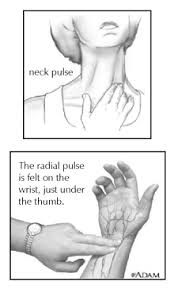 Hey everyone Brett Banford here and I have been meaning to address this topic for awhile now and that is how to calculate your target heart rate? Your target heart rate is very important and if you want to maximize the benefits that you get from cardiovascular activity then it is important that you know what your target heart rate (THR) is. It is not very hard to calculate, but there is a little bit of basic math involved. This post is going to give you a step by step guide of how to calculate your target rate.
Hey everyone Brett Banford here and I have been meaning to address this topic for awhile now and that is how to calculate your target heart rate? Your target heart rate is very important and if you want to maximize the benefits that you get from cardiovascular activity then it is important that you know what your target heart rate (THR) is. It is not very hard to calculate, but there is a little bit of basic math involved. This post is going to give you a step by step guide of how to calculate your target rate.
How to Calculate Your Target Heart Rate
It is important to note that before I go into the step by step guide that this method that your TRH is generally between 60% and 80%. The way I am going to show you how to calculate your target heart rate is based off the Karvonen Method, which is one of the most effective methods since it takes into account your resting heart rate (RHR).
Step 1: Find Your Resting Heart Rate
The best time to find your resting heart rate is in the morning when you first wake up. You will need to count your pulse for 60 seconds and this will determine your RHR. I would take an average of at least three days to make sure you are getting an accurate depiction of your RHR. So just take your RHR for three days and then add them all together and divide by three to get your average.
Finding Your Pulse
For those of you who do not have a fancy heart rate watch it is fairly easy to find your pulse. There are two main ways to find your pulse.
1. Neck pulse- the neck pulse can be found right under either side of your jaw bone towards the corner of the back of your jaw. Take your index and middle finger and feel around for it. If you are having a hard time finding it, do a few jumping jacks and get your heart rate up and it should make your pulse more noticeable.
2. Wrist pulse- your wrist pulse can be found on either one of your hands right underneath your thumb. I personally have a harder time finding this one, but that is just me and either one works just fine.
Step 2: Find Your Maximum Heart Rate and Heart Rate Reserve
Both of these are really easy to calculate. Your maximum heart rate (MHR) is simply the number 220 minus your age. So a 30 year old man would have a MHR of (220-30) 190. Your heart rate reserve (HRRes) is just simply the your MHR minus your RHR. So for a 30 year old with a MHR of 190 and a RHR of 66, their HRRes would be 124. Make’s sense right? Right!
Step 3: Find Your Upper and Lower THR
Based on the fact that we have established our THR zone as being 60-80% of our MHR these will be our lower and upper limits. To calculate each limit you multiply your HRRes by the limit and then add your RHR, in that order. So for the example with our 30 year old:
1. Lower Limit: [124(HRRes) x 0.60(limit)] + 66(RHR) = ~140
2. Upper Limit: [124(HRRes) x 0.80(limit)] + 66(RHR) = ~165
Step 4: Calculating Your THR
The last step is very simple and will give you your THR. All you have to do is take the two numbers you calculated for your upper and lower limits add them together and divide by 2. So you are essentially averaging the two to calculate your THR. So in finishing our example:
Calculated THR = (165+140)/2 =~153
 How to Calculate Your Target Heart Rate: Final Remarks
How to Calculate Your Target Heart Rate: Final Remarks
I hope this post helped you find out how to calculate your target heart rate. As mentioned in the beginning knowing what your target heart rate is will help you maximize the benefits you can achieve from cardiovascular activity. If you want to make sure you are in your target heart rate zone while your exercising then I recommend whenever you take a quick break to count your pulse for 30 seconds and then multiply by 2. This will give you close to what your current heart rate is.
If you have anymore questions or concerns about how to calculate your target heart rate than be sure to leave a comment below!
Yours in Success,

Brett Banford
Work with me –Leaders Only!
My Blog: http://brett-banford.com
[hr]